- Back to Home »
- Enduring lessons of JFK's presidency
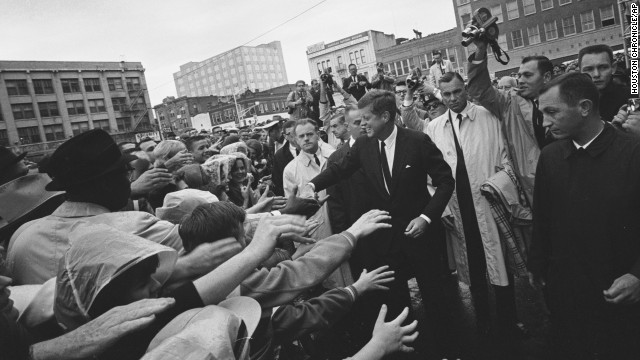 President John F. Kennedy greets supporters during his visit to Fort Worth, Texas, on Friday, November 22, 1963. This month marks 50 years since his assassination in Dallas, an event that jarred the nation and fueled a multitude of conspiracy theories about whether Kennedy was killed by a single gunman acting alone in the Texas School Book Depository. Here are some images from that fateful day as it unfolded.
President John F. Kennedy greets supporters during his visit to Fort Worth, Texas, on Friday, November 22, 1963. This month marks 50 years since his assassination in Dallas, an event that jarred the nation and fueled a multitude of conspiracy theories about whether Kennedy was killed by a single gunman acting alone in the Texas School Book Depository. Here are some images from that fateful day as it unfolded. 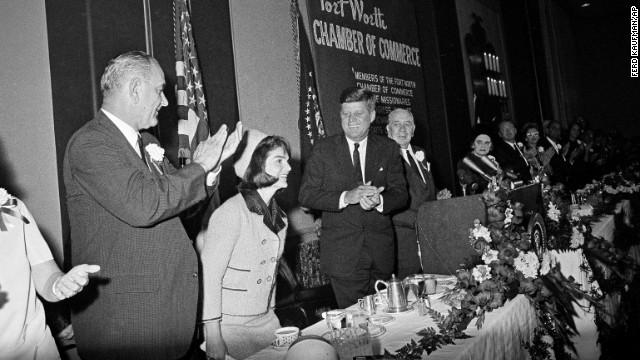 First lady Jacqueline Kennedy at a breakfast held by the Chamber of Commerce in Fort Worth with Vice President Lyndon B. Johnson, left, and Kennedy.
First lady Jacqueline Kennedy at a breakfast held by the Chamber of Commerce in Fort Worth with Vice President Lyndon B. Johnson, left, and Kennedy. 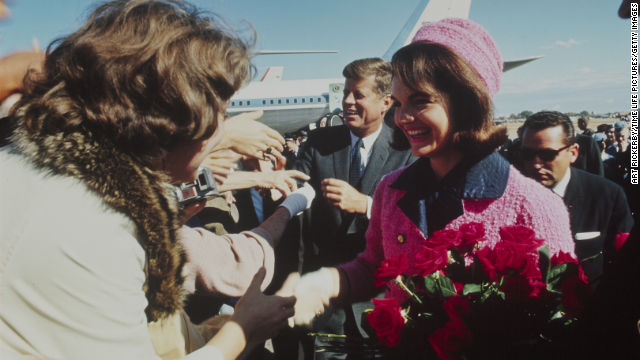 The Kennedys arrive at Love Field in Dallas on a trip to advance the upcoming 1964 campaign.
The Kennedys arrive at Love Field in Dallas on a trip to advance the upcoming 1964 campaign.  About 11:45 a.m., Texas Gov. John B. Connally Jr., waving to the crowd, and the Kennedys depart Love Field for a 10-mile tour of Dallas. The President asked about the weather earlier in the day and opted not to have a top on the limousine.
About 11:45 a.m., Texas Gov. John B. Connally Jr., waving to the crowd, and the Kennedys depart Love Field for a 10-mile tour of Dallas. The President asked about the weather earlier in the day and opted not to have a top on the limousine. 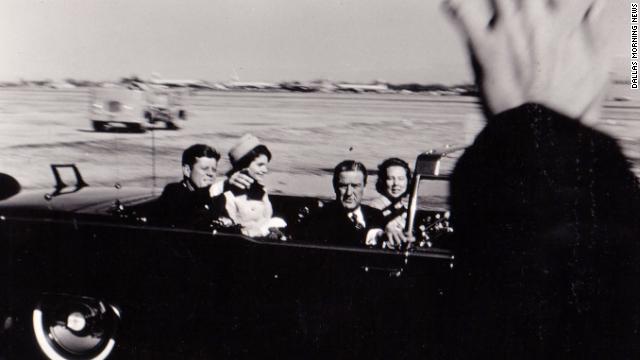 The Kennedys and Connallys leave Love Field with Secret Service Agent Bill Greer driving the presidential limousine. The motorcade is on the way to the Trade Mart, where Kennedy is to speak at a sold-out luncheon.
The Kennedys and Connallys leave Love Field with Secret Service Agent Bill Greer driving the presidential limousine. The motorcade is on the way to the Trade Mart, where Kennedy is to speak at a sold-out luncheon. 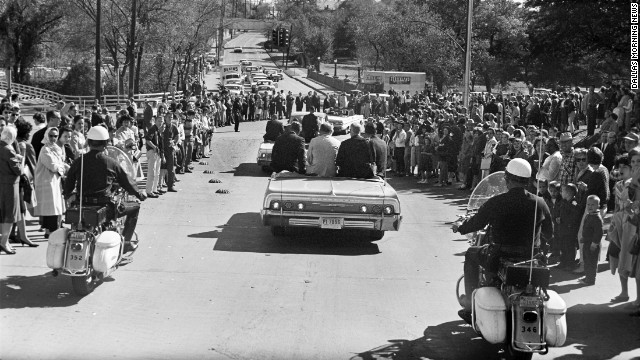 Crowds line the street as Kennedy's motorcade heads toward downtown Dallas. A group of White House staffers follows the motorcade in a bus several vehicles behind the presidential limousine.
Crowds line the street as Kennedy's motorcade heads toward downtown Dallas. A group of White House staffers follows the motorcade in a bus several vehicles behind the presidential limousine. 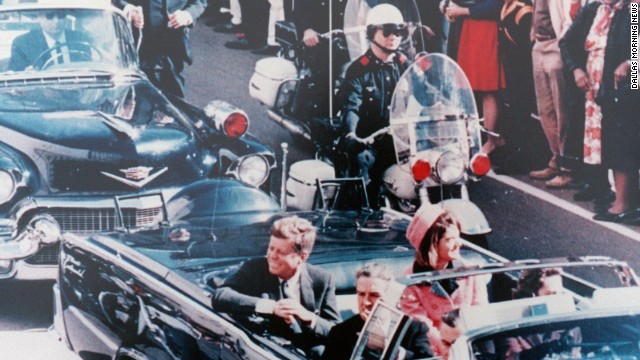 Dallas Police Officer Bobby Hargis, background, is one of four motorcycle officers assigned to Kennedy's car, which reaches Houston Street shortly before 12:30 p.m. "I thought, 'Well, we've got it made now,' " Hargis said. "And then bam! It happens."
Dallas Police Officer Bobby Hargis, background, is one of four motorcycle officers assigned to Kennedy's car, which reaches Houston Street shortly before 12:30 p.m. "I thought, 'Well, we've got it made now,' " Hargis said. "And then bam! It happens." 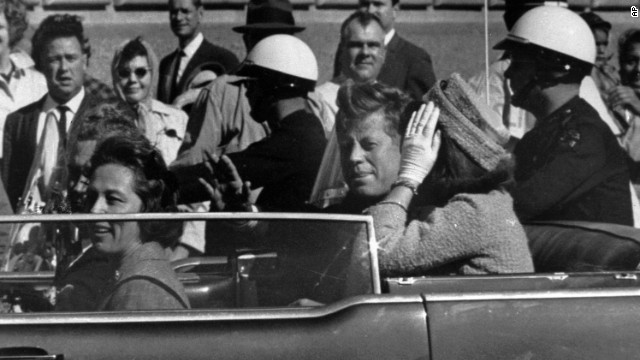 Kennedy is seen approximately one minute before he is shot.
Kennedy is seen approximately one minute before he is shot. 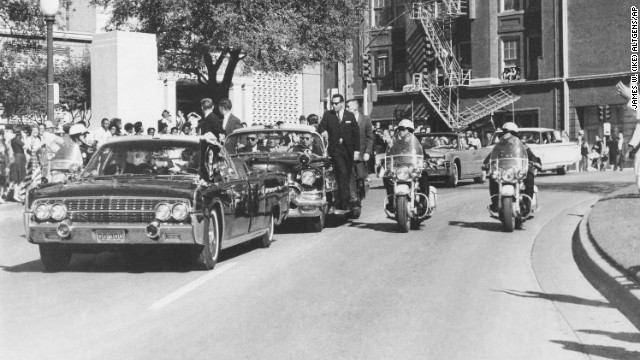 Seen through the limousine's windshield as it proceeds along Elm Street past the Texas School Book Depository, Kennedy appears to raise his hand toward his head after being shot. The first lady holds Kennedy's forearm in an effort to aid him.
Seen through the limousine's windshield as it proceeds along Elm Street past the Texas School Book Depository, Kennedy appears to raise his hand toward his head after being shot. The first lady holds Kennedy's forearm in an effort to aid him. 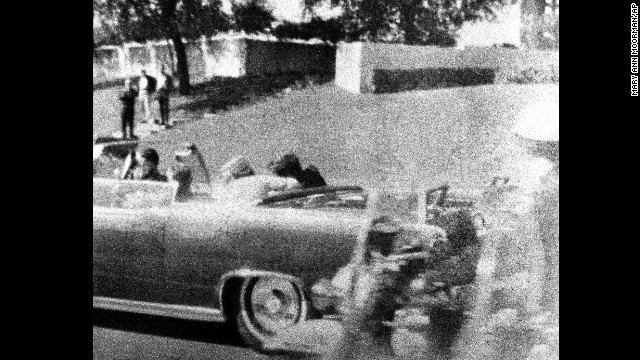 Kennedy slumps against his wife as the bullet strikes him in the head. Connally, who is wounded in the attack, begins to turn around just to the left of Jackie Kennedy.
Kennedy slumps against his wife as the bullet strikes him in the head. Connally, who is wounded in the attack, begins to turn around just to the left of Jackie Kennedy. 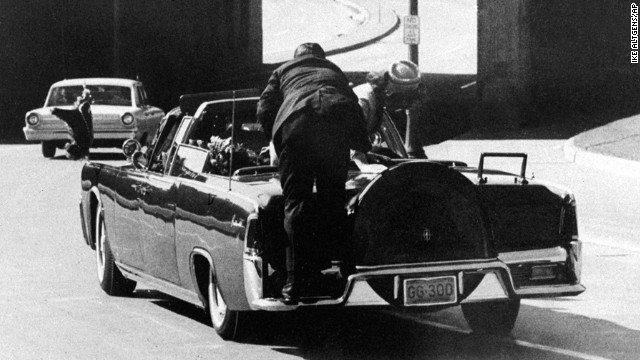 Kennedy slumps in the back seat of the car and his wife leans over to him as Secret Service Agent Clinton Hill rides on the back of the car.
Kennedy slumps in the back seat of the car and his wife leans over to him as Secret Service Agent Clinton Hill rides on the back of the car. 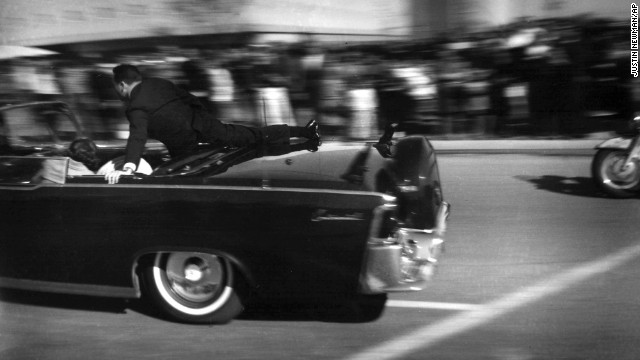 The limousine carrying the mortally wounded President races toward the hospital seconds after three shots are fired. Two bullets hit Kennedy and one hit Connally. Hill rides on the back of the car as the wives cover their stricken husbands.
The limousine carrying the mortally wounded President races toward the hospital seconds after three shots are fired. Two bullets hit Kennedy and one hit Connally. Hill rides on the back of the car as the wives cover their stricken husbands. 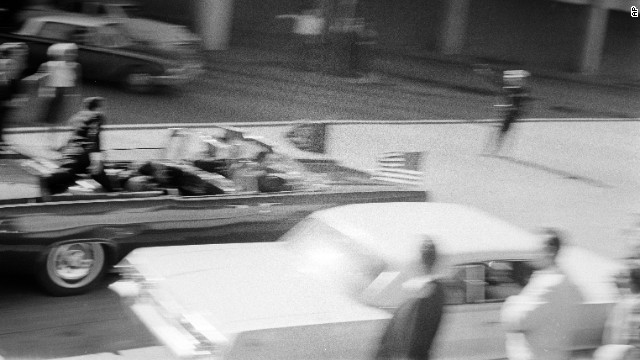 The limousine speeds along Elm Street toward the Stemmons Freeway overpass moments after shots are fired at Dealey Plaza.
The limousine speeds along Elm Street toward the Stemmons Freeway overpass moments after shots are fired at Dealey Plaza. 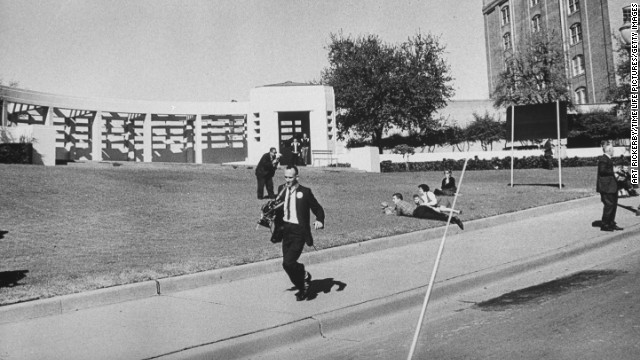 Photographers are seen running shortly after the shooting.
Photographers are seen running shortly after the shooting.  Hurchel Jacks, Vice President Johnson's driver in the motorcade, listens with others to news accounts on the car radio outside the Parkland Hospital emergency entrance. After the shots were fired, Jacks had rerouted the vice president's car to safety. The ABC radio network broadcast the first nationwide news bulletin reporting that shots have been fired at the Kennedy motorcade.
Hurchel Jacks, Vice President Johnson's driver in the motorcade, listens with others to news accounts on the car radio outside the Parkland Hospital emergency entrance. After the shots were fired, Jacks had rerouted the vice president's car to safety. The ABC radio network broadcast the first nationwide news bulletin reporting that shots have been fired at the Kennedy motorcade. 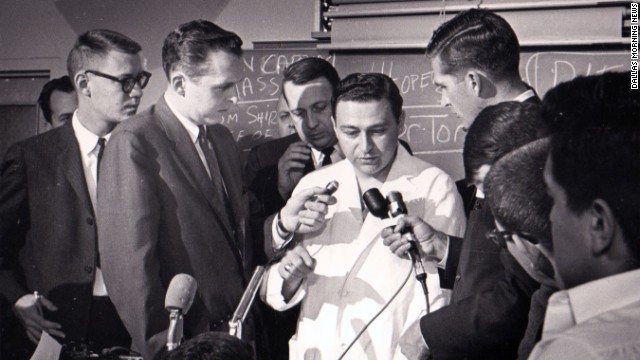 Before 1 p.m., Dr. Tom Shires, with Parkland public relations director Steve Landregan, rear, describes the President's wounds to the press. Four doctors worked on the stricken Kennedy in the emergency room.
Before 1 p.m., Dr. Tom Shires, with Parkland public relations director Steve Landregan, rear, describes the President's wounds to the press. Four doctors worked on the stricken Kennedy in the emergency room. 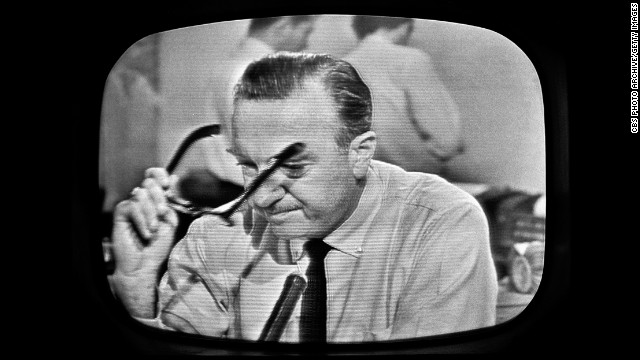 American broadcast journalist and anchorman Walter Cronkite removes his glasses and prepares to announce Kennedy's death. CBS broadcast the first nationwide TV news bulletin reporting on the shooting.
American broadcast journalist and anchorman Walter Cronkite removes his glasses and prepares to announce Kennedy's death. CBS broadcast the first nationwide TV news bulletin reporting on the shooting. 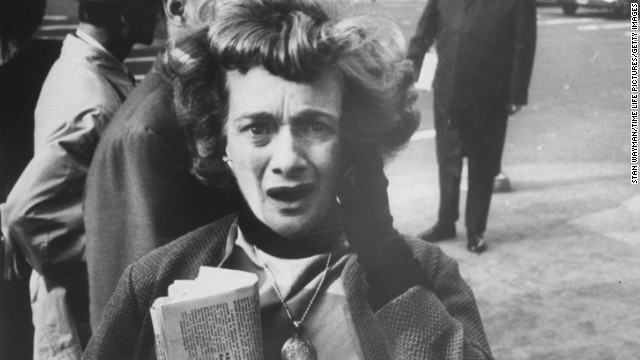 A photographer captures a New Yorker's expression of shock upon hearing the news. At 1 p.m. the 46-year-old President of the United States is declared dead, becoming the fourth U.S. president killed in office.
A photographer captures a New Yorker's expression of shock upon hearing the news. At 1 p.m. the 46-year-old President of the United States is declared dead, becoming the fourth U.S. president killed in office.  After 2 p.m., Jacqueline Kennedy leaves Parkland Hospital with her slain husband's body. She would ride in the back with the bronze casket. "I had a feeling that if somebody had literally fired a pistol in front of her face that she would just have blinked," said Dallas Police Officer James Jennings, who helped put the casket in the hearse.
After 2 p.m., Jacqueline Kennedy leaves Parkland Hospital with her slain husband's body. She would ride in the back with the bronze casket. "I had a feeling that if somebody had literally fired a pistol in front of her face that she would just have blinked," said Dallas Police Officer James Jennings, who helped put the casket in the hearse. 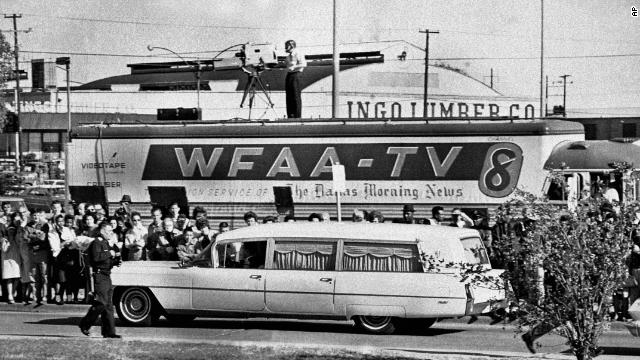 The hearse carrying Kennedy's body pulls away from Parkland Hospital en route to the airport.
The hearse carrying Kennedy's body pulls away from Parkland Hospital en route to the airport. 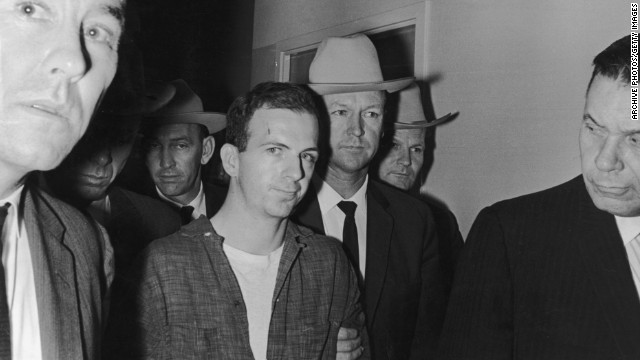 Lee Harvey Oswald, a 24-year-old ex-Marine, is arrested in the back of a movie theater where he fled after shooting Dallas Police Patrolman J.D. Tippit. That incident occurred approximately 45 minutes after the assassination.
Lee Harvey Oswald, a 24-year-old ex-Marine, is arrested in the back of a movie theater where he fled after shooting Dallas Police Patrolman J.D. Tippit. That incident occurred approximately 45 minutes after the assassination. 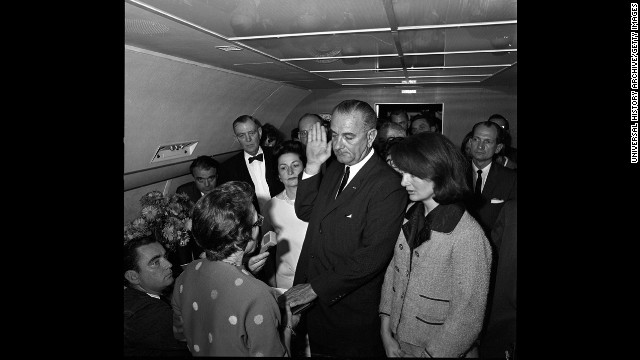 Vice President Lyndon Johnson takes the oath of office to become the 36th president of the United States. He is sworn in by U.S. Federal Judge Sarah T. Hughes, left, with Jacqueline Kennedy by his side on Air Force One.
Vice President Lyndon Johnson takes the oath of office to become the 36th president of the United States. He is sworn in by U.S. Federal Judge Sarah T. Hughes, left, with Jacqueline Kennedy by his side on Air Force One. 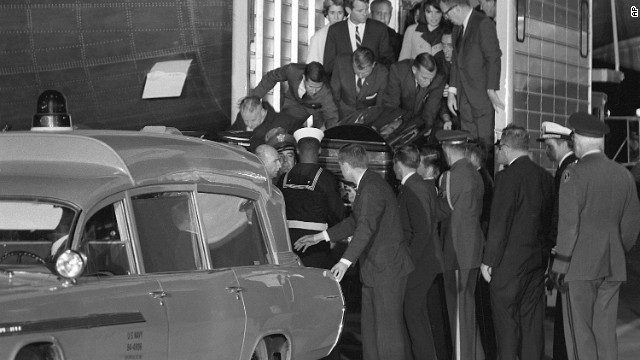 The casket containing the body of President Kennedy is moved to a Navy ambulance from the presidential plane. Jacqueline Kennedy and Attorney General Robert Kennedy stand behind on the elevator.
The casket containing the body of President Kennedy is moved to a Navy ambulance from the presidential plane. Jacqueline Kennedy and Attorney General Robert Kennedy stand behind on the elevator. 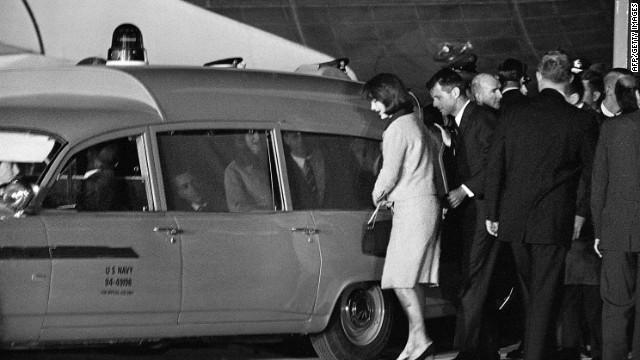 Jacqueline and Robert Kennedy get into the Navy ambulance with the president's body at Andrews Air Force Base, just outside Washington. The body of the president is taken to Bethesda Naval Hospital for an immediate autopsy.
Jacqueline and Robert Kennedy get into the Navy ambulance with the president's body at Andrews Air Force Base, just outside Washington. The body of the president is taken to Bethesda Naval Hospital for an immediate autopsy. 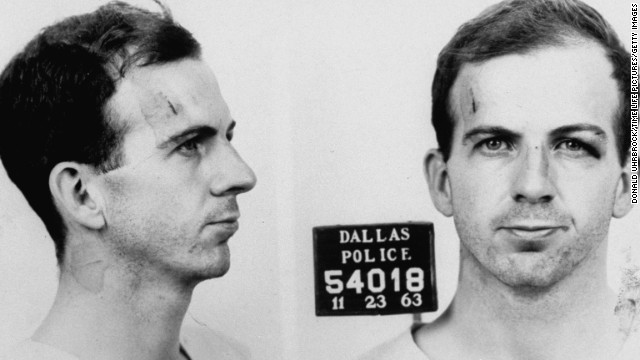 Police mug shot of Lee Harvey Oswald. He is arraigned in the slaying of Officer Tippit on November 22 and/or the murder of the president the next day. As Oswald is being transferred from the Dallas city jail to the county jail, nightclub owner Jack Ruby shoots and kills him, an event captured live on TV. Ruby is arrested immediately.
Police mug shot of Lee Harvey Oswald. He is arraigned in the slaying of Officer Tippit on November 22 and/or the murder of the president the next day. As Oswald is being transferred from the Dallas city jail to the county jail, nightclub owner Jack Ruby shoots and kills him, an event captured live on TV. Ruby is arrested immediately. 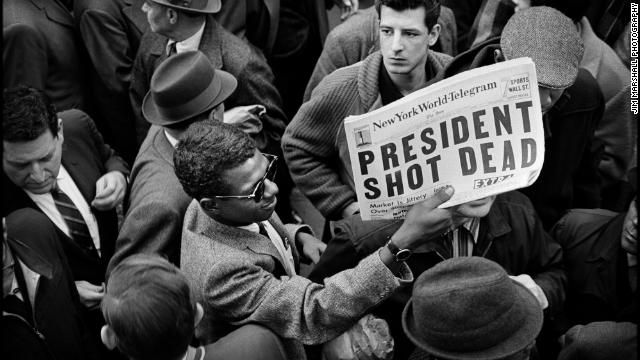 A man holds up a copy of the New York World-Telegram featuring the news of the assassination. Major television and radio networks devote continuous news coverage to the events of the day, canceling all entertainment and all commercials. Many theaters, stores and businesses, including stock exchanges and government offices, are closed.
A man holds up a copy of the New York World-Telegram featuring the news of the assassination. Major television and radio networks devote continuous news coverage to the events of the day, canceling all entertainment and all commercials. Many theaters, stores and businesses, including stock exchanges and government offices, are closed. 
1

2

3

4

5

6

7

8

9

10

11

12

13

14

15

16

17

18

19

20

21

22

23

24

25

26
- Friday marks the 50th anniversary of the assassination of John F. Kennedy
- Presidency offers lessons on U.S. policy in Mideast and China - Andrew Hammond
- Hammond: JFK powerfully renewed U.S. global leadership, helping to thaw Cold War
- Objective appraisal of JFK's presidency must highlight lows and highs, he adds
Editor's note: Andrew Hammond was formerly a special adviser in the government of former UK Prime Minister Tony Blair, and also a geopolitical analyst at Oxford Analytica.
(CNN) -- This Friday marks the 50th anniversary of the assassination of John F. Kennedy, one of history's most notable figures. Despite holding office for less than a full term, he has long been perceived by the U.S. public as one of the best occupants of the White House.
Yet JFK's presidency is inspiring not just to Americans, but also to many others around the world too. And it offers key lessons for today, ranging from U.S. policy in the Middle East post-9/11, to how to best engage a "rising" China.
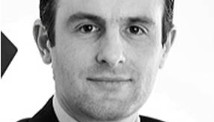
At a time when U.S.-Soviet rivalry was becoming heavily militarized, JFK's political genius was to appreciate that the superpower contest was as much a battle for ideas as strength of force. Through his skilful rebalancing of hard and soft power, he powerfully renewed U.S. global leadership, helping to thaw the Cold War.
Here his projection of hope and optimism, and stirring rhetoric appealed to U.S. and international audiences alike, including those behind the Iron Curtain. Landmark speeches included the one he made in Berlin in 1963 when he offered U.S. solidarity with West Germany.
And his desire to re-set U.S.-Soviet relations was expressed eloquently too, including a compelling speech at the American University after the Cuban missile crisis. This was described even by Soviet Premier Nikita Khrushchev as the "the greatest speech by any U.S. president since [Franklin] Roosevelt."
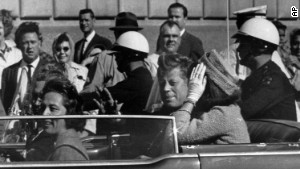 New photos of JFK's final minutes
New photos of JFK's final minutes 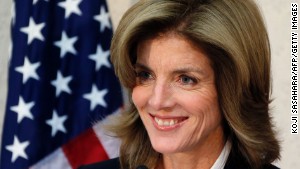 Kennedy in Japan
Kennedy in Japan 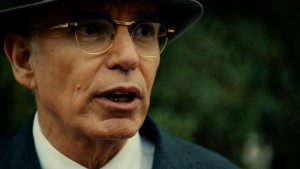 Film shows JFK's death from unseen angles
Film shows JFK's death from unseen angles Renewal of U.S. international policy was not just rhetorical, as initiatives like the Peace Corps and the South America-focused Alliance for Progress underline. And, through landmark achievements such as the International Nuclear Test Ban Treaty, JFK gave substance to his ambition of moving toward international peace.
To be sure, an objective appraisal of JFK's period in the White House must highlight lows as well as the highs. In addition to successes such as his management of the Cuban missile crisis, there was also the Bay of Pigs invasion debacle.
And JFK had a much more limited record of legislative success than his successor Lyndon Johnson. Professional historians therefore tend to rate JFK's presidency as "good," rather than "great," with reason.
Of course, the circumstances of today are transformed from those of the early 1960s. As well as the end of the Cold War, the United States has experienced relative decline: for instance, its economy now accounts for less than a quarter of global GDP compared to around a third then.
Yet, the relevance of JFK's insights about international cooperation and peace endure. As does the wisdom of much of the way in which he harnessed U.S. leadership and power to try to achieve these ends.
Indeed, at a time of U.S. military cutbacks, and given the ongoing information revolution, the importance of achieving better balance between -- often expensive -- hard power assets and soft power resources is perhaps even more important today for Washington. And this is true right across the world from Asia-Pacific through the Middle East and South America.
On China policy, for instance, some U.S. hawks advocate a much tougher stance toward Beijing. However, as JFK would have recognized, Washington has much to gain from cooperation with Beijing too, and it would be a mistake to view the relationship solely through a lens of threat and suspicion.
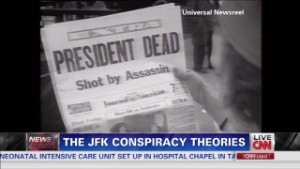 JFK conspiracy theories
JFK conspiracy theories 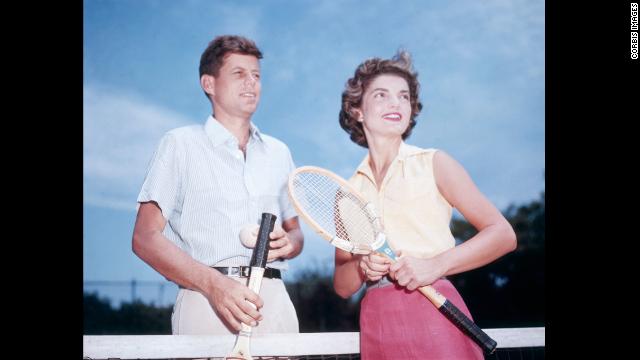 John Fitzgerald Kennedy and his fiancée, Jacqueline Lee Bouvier, playing tennis in 1953. They were history's power couple, a dashing Democrat and an elegant wife. They were both from influential families and became superstars before he entered the White House. Take a look back at the couple that embodied the image of a perfect family.
John Fitzgerald Kennedy and his fiancée, Jacqueline Lee Bouvier, playing tennis in 1953. They were history's power couple, a dashing Democrat and an elegant wife. They were both from influential families and became superstars before he entered the White House. Take a look back at the couple that embodied the image of a perfect family. 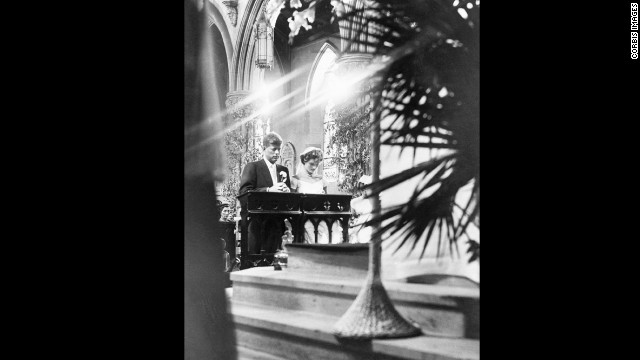 John Kennedy and Jacqueline Bouvier met in 1951 and after a brief engagement, they married in Rhode Island in the century-old church of St. Mary's on September 12, 1953.
John Kennedy and Jacqueline Bouvier met in 1951 and after a brief engagement, they married in Rhode Island in the century-old church of St. Mary's on September 12, 1953. 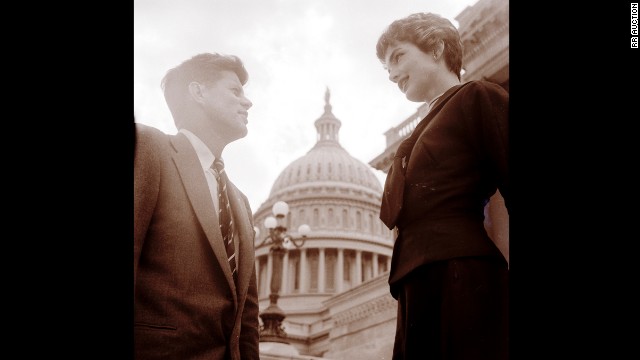 John F. Kennedy and Jacqueline Kennedy at the U.S. Capitol on May 6, 1954.
John F. Kennedy and Jacqueline Kennedy at the U.S. Capitol on May 6, 1954. 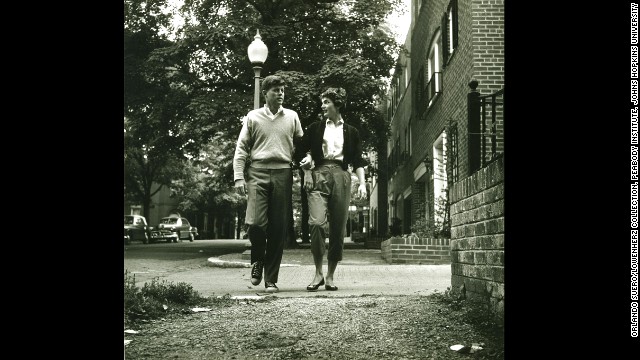 The couple strolling in the Georgetown area of Washington on May 8, 1954.
The couple strolling in the Georgetown area of Washington on May 8, 1954. 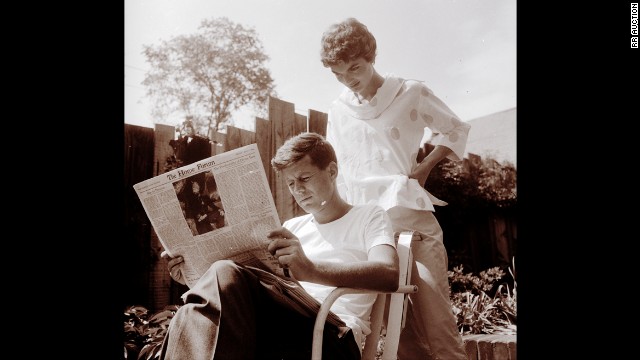 Jackie looking over John's shoulder as he reads the May 7 issue of the Christian Science Monitor on May 9, 1954, Mother's Day.
Jackie looking over John's shoulder as he reads the May 7 issue of the Christian Science Monitor on May 9, 1954, Mother's Day. 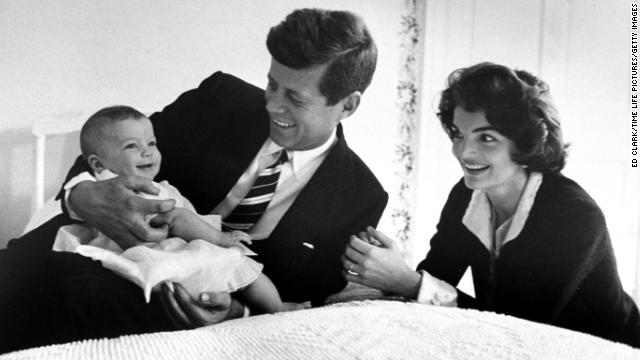 The Kennedy's cuddle daughter Caroline while relaxing on a bed at home on March 25, 1958.
The Kennedy's cuddle daughter Caroline while relaxing on a bed at home on March 25, 1958. 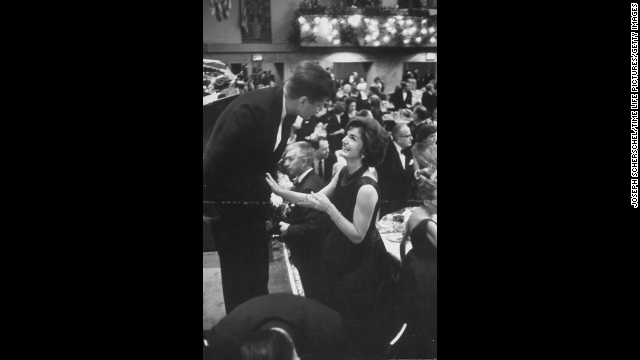 John and Jackie at Eleanor Roosevelt's 75th birthday celebration in 1959.
John and Jackie at Eleanor Roosevelt's 75th birthday celebration in 1959.  The then-senator engages in his favorite pastime of sailing at Hyannisport, Massachusetts, with Jackie in July 1960.
The then-senator engages in his favorite pastime of sailing at Hyannisport, Massachusetts, with Jackie in July 1960. 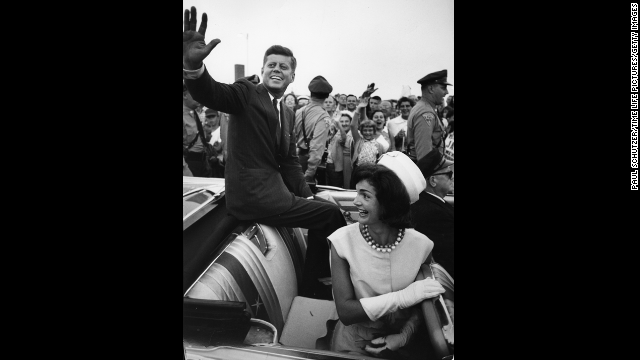 Shortly after his acceptance of the Democratic Party nomination for president, Kennedy and his wife smile and wave from the back of an open-top car in Massachusetts in July 1960.
Shortly after his acceptance of the Democratic Party nomination for president, Kennedy and his wife smile and wave from the back of an open-top car in Massachusetts in July 1960.  Jacqueline greets her husband in 1960.
Jacqueline greets her husband in 1960. 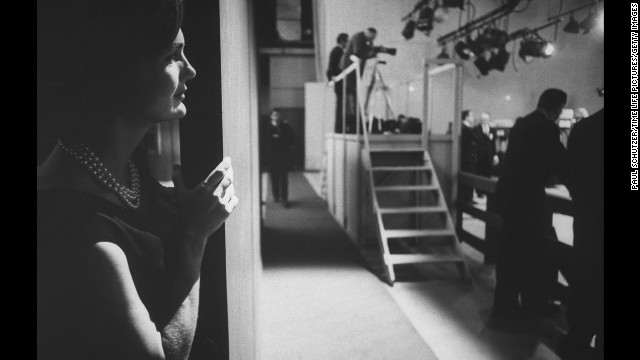 Jackie watches her husband during a presidential debate in September 1960.
Jackie watches her husband during a presidential debate in September 1960. 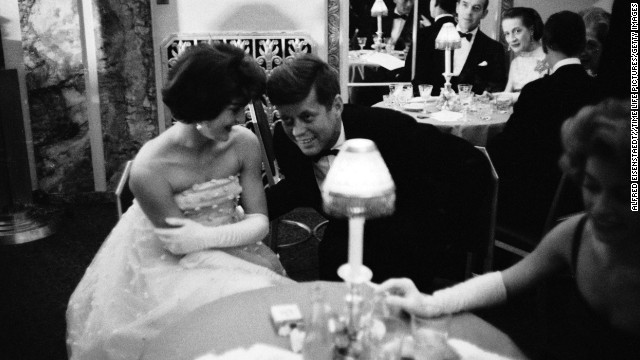 Kennedy lends an ear to his wife as they sit together at a table during cocktail hour before dining at a society gala at the Walford Astoria Hotel in 1960.
Kennedy lends an ear to his wife as they sit together at a table during cocktail hour before dining at a society gala at the Walford Astoria Hotel in 1960. 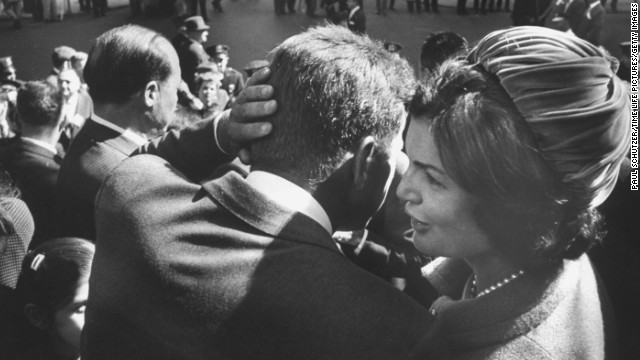 Kennedy, campaigning for president, listens to the whispers of his wife in 1960.
Kennedy, campaigning for president, listens to the whispers of his wife in 1960. 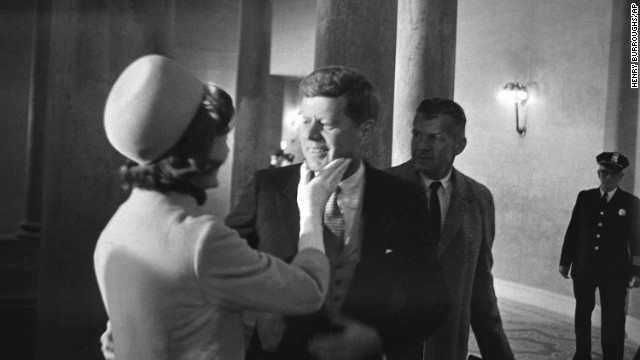 Jackie shares a moment with her husband before he became president, in January 20, 1961, in the rotunda of the Capitol. She became the youngest first lady in nearly 80 years.
Jackie shares a moment with her husband before he became president, in January 20, 1961, in the rotunda of the Capitol. She became the youngest first lady in nearly 80 years. 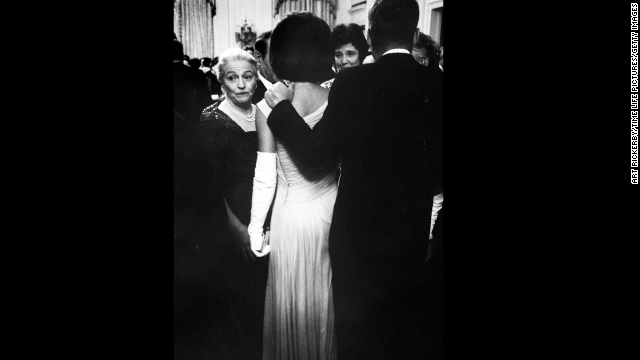 President Kennedy and Jackie greet guests at a party for Nobel Prize winners at the White House on April 29, 1961.
President Kennedy and Jackie greet guests at a party for Nobel Prize winners at the White House on April 29, 1961. 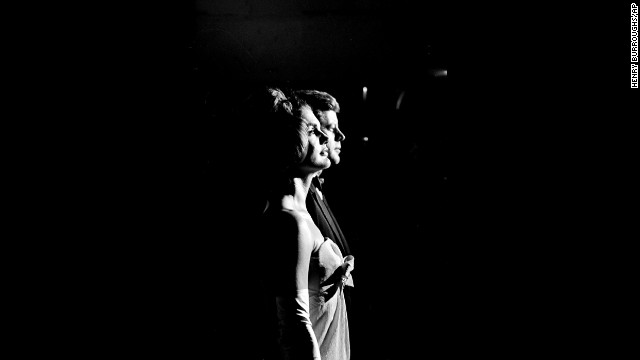 The Kennedys stand at attention during the playing of the national anthem at the start of a reception during their state visit to Mexico City on June 30, 1962.
The Kennedys stand at attention during the playing of the national anthem at the start of a reception during their state visit to Mexico City on June 30, 1962.  John and Jackie at Union Station after the departure of King Hassan of Morocco on March 27, 1963.
John and Jackie at Union Station after the departure of King Hassan of Morocco on March 27, 1963. 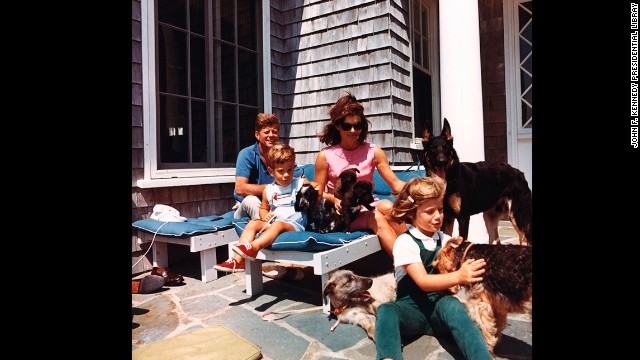 President Kennedy, John F. Kennedy Jr., Jackie and Caroline with puppies Blackie and White Tips, and family dogs Shannon, Clipper, Wolfie and Charlie on August 14, 1963.
President Kennedy, John F. Kennedy Jr., Jackie and Caroline with puppies Blackie and White Tips, and family dogs Shannon, Clipper, Wolfie and Charlie on August 14, 1963. 
1

2

3

4

5

6

7

8

9

10

11

12

13

14

15

16

17

18
 John and Jackie: A love story
John and Jackie: A love story To be sure, there remains a legitimate remaining need for maintaining significant U.S. military power in Asia, not least to re-assure key allies. However, on issues ranging from North Korea, terrorism, through to the future stability of the global economy, China has a potentially key role to play in concert with the United States.
Here the role of soft power is key as Washington seeks to better integrate Beijing into a network of regional and global institutions and alliances. In so doing, this will help incentivize China even more strongly toward a path of constructive partnership.
In the Middle East meanwhile, U.S. standing in numerous countries has unfortunately been at a low ebb now for at least a decade. Only 11% of the population in Pakistan, 14% in Jordan, 16% in Egypt and the Palestinian territories, and 21% in Turkey, currently have favourable views toward the United States, according to Pew Global.
Despite some U.S. overtures, the challenge remains monumental. This is such a critical issue given the wide-range of U.S. priorities in Middle Eastern and other Muslim-majority countries, including the "campaign against terrorism."
As JFK would surely have appreciated, there is a compelling need for redoubling efforts to win the battle for moderate "hearts and minds." This can be best achieved through a vigorous re-assertion of U.S. soft power, combined with prudent use of hard power.
Such an agenda would require much greater resourcing for activities such as public diplomacy, broadcasting, development assistance and exchange programs. U.S. public diplomacy is in particularly strong need of revitalization, with a clearer long-term strategy essential.
Taken overall, it is clear that JFK's key insights about international relations retain much relevance and appeal. And for this reason alone, his presidency will continue to hold not just enduring value, but also inspiration, right across the world for many years to come.
The opinions expressed in this commentary are solely those of Andrew Hammond.







